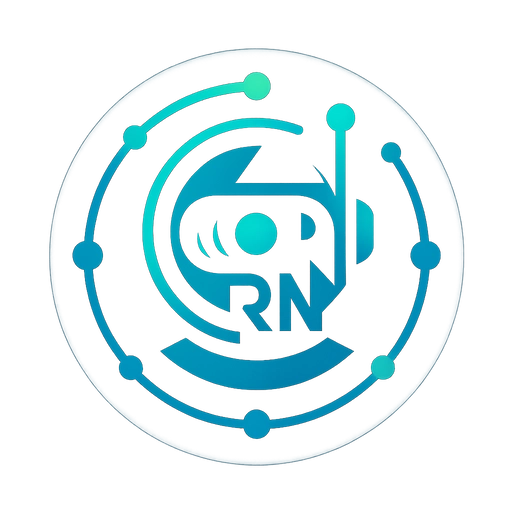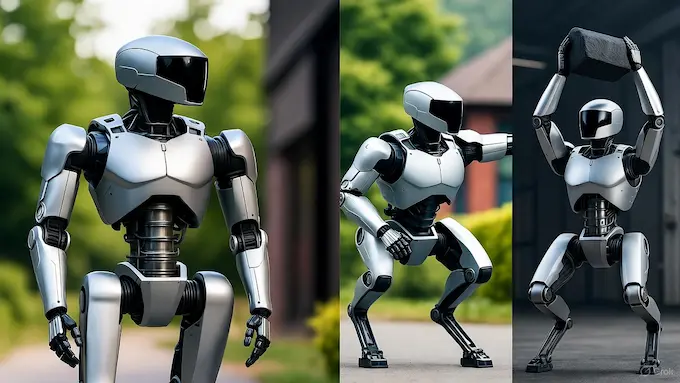Table of Contents
Introduction
In the rapidly evolving robotics landscape, few names carry as much weight as Boston Dynamics Atlas. For years, Atlas has captured the public imagination with its acrobatic flips, balance stunts, and agile motion sequences. Now, with its transition to a fully electric platform, the new Boston Dynamics Atlas aims to redefine what humanoid robots can do. This review dives deep into the Boston Dynamics Atlas review, covering its specifications, architecture, capabilities, limitations, market position, and future potential.
This article takes you through a technical journey from the historical evolution of Atlas, through sensor systems, actuation, AI control, and real-world use case scenarios. It also benchmarks Boston Dynamics Atlas against competitors such as Tesla Optimus, Figure 01, and Apptronik Apollo. By the end, you’ll understand not only “What can the new Atlas robot do?” and “How does the Boston Dynamics Atlas work?”, but also whether it’s viable for commercial deployment today.
From Hydraulic Legacy to Electric Grace: The Evolution of Atlas
Launched originally under DARPA funding, the Atlas series has long been Boston Dynamics’ flagship humanoid project. The early versions were hydraulically actuated, tethered, and primarily used for research, often showcased doing parkour, navigating terrain, and recovering from pushes. Wikipedia+2IEEE Spectrum+2
In April 2024, Boston Dynamics officially retired the hydraulic Atlas (HD Atlas) and unveiled a next-generation all-electric Atlas robot the very next day. Brian D. Colwell+3Wikipedia+3Boston Dynamics+3 This new Boston Dynamics Atlas represents a fundamental shift replacing hydraulics with custom electric actuators for all joints. The motivation? Cleaner, more agile motion, reduced maintenance complexity, and better synergy with AI control loops. Boston Dynamics+2IEEE Spectrum+2
While early Atlas robots were constrained by human-like joint ranges, the electric version is designed to move beyond human limits enabling joints to rotate more freely, twist, and move in configurations no human could replicate. Boston Dynamics+2IEEE Spectrum+2 In other words, the Boston Dynamics Atlas is no longer bound by a human skeleton it is built for machine-native agility.
This shift marks a turning point: where the old Atlas was a demonstration platform, the new Boston Dynamics Atlas is intended as a stepping stone toward real-world deployment. It’s both a technology showcase and a base for future commercial applications.
Atlas Key Specifications at a Glance
Here’s a snapshot of the key technical specs of Boston Dynamics Atlas (as publicly available or estimated) to ground the deeper analysis:
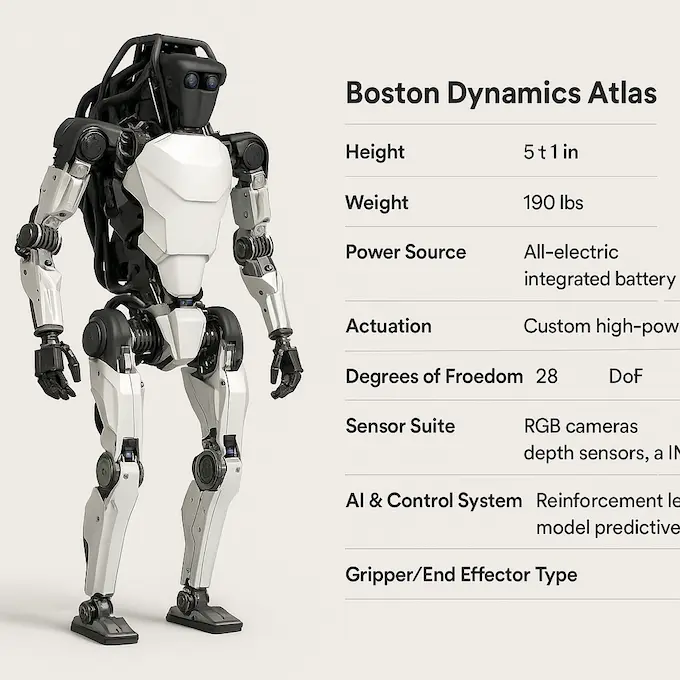
These figures are a combination of official Boston Dynamics disclosures and industry estimates. Given that the Boston Dynamics Atlas remains in a research and development phase, some values (e.g. battery runtime, payload) are speculative or predicted.
Deep Dive: The Technology Powering Atlas
Unmatched Mobility: Beyond Human Movement
One of the most striking aspects of the new Boston Dynamics Atlas is how it moves. In recent public demonstrations, Atlas has performed fluid walk-run transitions, cartwheels, breakdancing, handstands, and flips all with confidence and apparent anticipation. Boston Dynamics+3New Atlas+3Boston Dynamics+3 In one video, Atlas seamlessly converts a roll into a handstand and then into a roundoff behavior impossible under strict human biomechanics. New Atlas+1
How? The key lies in its electric actuators and rotational joint design. Whereas the older hydraulic Atlas was constrained by actuators that had limited rotational freedom (for example, limited joint range or torque directionality), the new Boston Dynamics Atlas uses custom high-torque electric actuators that allow multi-axis rotation, twisting, and reorientation mid-motion. Boston Dynamics+2IEEE Spectrum+2
Combined with precise torque control, these actuators enable dynamic balancing the robot continuously measures forces, velocities, and orientations and applies compensation instantly to maintain stability even when disturbed. This allows the robot to recover from pushes, slips, or external perturbations mid-motion. New Atlas+3Boston Dynamics+3Boston Dynamics+3 The result is not stiff, robotic motions, but fluid, life-like agility.
The Boston Dynamics Atlas also has no need to strictly follow human joint limits: in many tests, it bends backward, rotates at the waist or hips 360°, or contorts in ways humans can’t. That freedom enables it to negotiate tight spaces, reorient mid-stride, and perform multi-axis maneuvers giving it a distinct edge in agility among humanoids. New Atlas+2Boston Dynamics+2
Perception & Intelligence: Seeing and Adapting with AI
Mobility is only half the story. For Boston Dynamics Atlas to be useful beyond laboratory demos, it needs perception, planning, adaptation, and continuous learning.
Vision & Sensor Fusion
Atlas uses a robust sensor suite RGB cameras, depth/stereo sensors, and IMUs. These sensors feed perception models that recognize scene structure, objects, obstacles, and spatial relationships. IEEE Spectrum+3Boston Dynamics+3Boston Dynamics+3 The vision system is designed not just to detect objects but to align perception with physical models for example, using keypoints on shelving units so Atlas can place or insert parts with centimeter precision. Boston Dynamics
Boston Dynamics recently partnered with LG Innotek to develop a single vision module combining RGB and 3D sensing to improve low-light and adverse condition performance. IOT World Today This reinforces that perception is a continuing evolution in Atlas development.
AI & Learning
To control such a dynamic robot, Boston Dynamics leverages reinforcement learning (RL), model predictive control, and hybrid methods. Some motion policies are derived from human motion capture and then adapted via simulation and reinforcement loops. YouTube+2Boston Dynamics+2 RL enables Atlas to learn new behaviors as building blocks, and combine them dynamically in real time.
In 2025, Boston Dynamics announced a collaboration with Toyota Research Institute to use Large Behavior Models (LBM) to orchestrate complex sequences combining locomotion and manipulation tasks without hand-coding every transition. Toyota USA Newsroom This modular behavior modeling significantly accelerates deployment of new skills, allowing Atlas to adapt to new tasks via behavior composition.
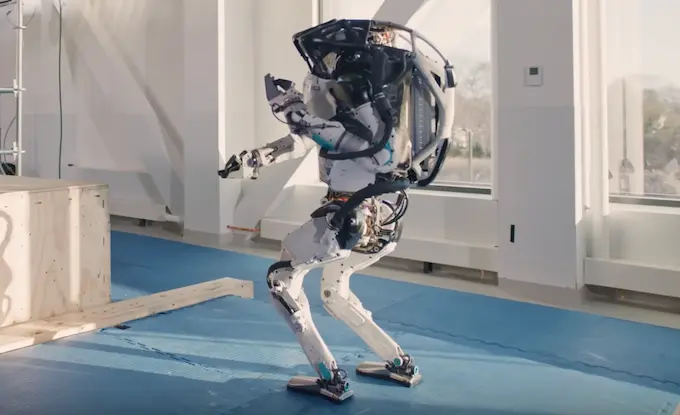
Also, Boston Dynamics’ integration of NVIDIA Isaac GR00T and Jetson Thor compute hardware gives the robot a powerful AI stack for inference, perception modeling, and real-time control. therobotreport.com The precise integration of learning, simulation (e.g. Isaac Sim), and real-world control is a competitive edge for Boston Dynamics Atlas.
Market Benchmark: How Atlas Stacks Up Against the Competition
The field of humanoid robotics is heating up. Below is a high-level performance benchmark comparing Boston Dynamics Atlas against its major peers Tesla Optimus, Figure 01, and Apptronik Apollo.
Performance Comparison & Analysis
Analysis:
- Boston Dynamics Atlas leads in mobility and agility, with fluid motion and dynamic recovery capabilities unmatched in publicly shown competitors.
- However, Atlas lags behind in commercial readiness: it is still primarily a research platform, not fully supported for wide deployment.
- Tesla Optimus emphasizes ease of programming and industrial use, but currently, its demonstration walks are conservative.
- Figure 01 and Apptronik focus on modular, industrial-compatible designs, which may offer easier integration in factories or service settings.
In short: Boston Dynamics Atlas is the agility and tech benchmark, whereas the others focus more on paths to commercialization and deployment.
Beyond the Lab: Potential Real-World Use Cases for Atlas
To make the Boston Dynamics Atlas viable, its performance needs to translate into value in real environments. Below are some promising use cases.
Manufacturing & Assembly
Atlas could assist in automotive factories, performing tasks like parts installation, wiring, quality inspections, or supporting human workers in complex manipulation tasks. In fact, a Hyundai pilot program has been hinted as an early deployment scenario for Atlas in their factories. WIRED+2Boston Dynamics+2 Its agility and adaptive planning could let it reach awkward positions, thread cables, or service complex mechanisms.
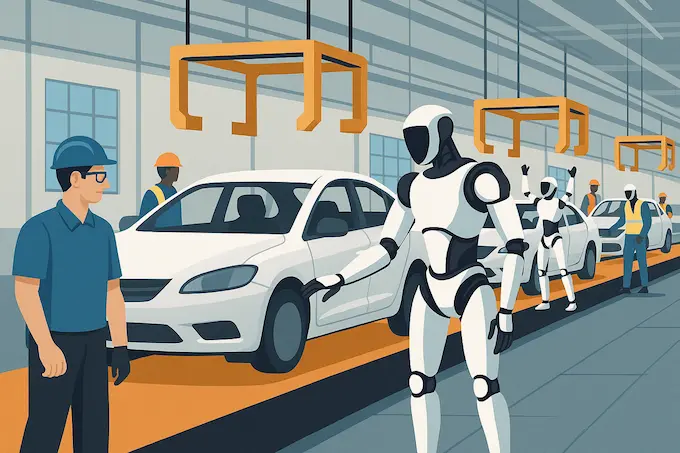
Warehouse & Logistics
In warehouses with mixed geometry, unstructured loads, and unpredictable spaces, Atlas’s flexibility could be an advantage. It could unload trucks, move boxes, re-stack pallets, or even sort irregular items. Its ability to adapt mid-motion gives it resilience in real-world logistics workflows.
Hazardous Environments & Infrastructure Inspection
Atlas may succeed where humans can’t nuclear plants, disaster zones, chemical spill sites, power plants, or oil rigs. Its robustness, agility, and autonomous planning make it an attractive candidate for remote inspection, maintenance, or emergency response tasks.
Search & Rescue
Classic to the Atlas narrative is deployment in search-and-rescue scenarios (rubble, uneven terrain, hazardous zones). While still hypothetical at this stage, the new Boston Dynamics Atlas is conceptually better equipped for such tasks, given its improved mobility, perception, and adaptive control.
The Final Analysis: Pros & Cons of Boston Dynamics Atlas
Below is a balanced assessment of the strengths and limitations of the Boston Dynamics Atlas platform.
Our Verdict: Is Atlas the Future of Automated Labor?
After this Boston Dynamics Atlas review, the verdict is: Boston Dynamics Atlas is a technological marvel the most physically capable humanoid robot publicly known today. It sets a new standard for what robots should be able to do. But it’s not yet ready for mass deployment.
Its strengths lie in agility, intelligent control, and engineering excellence. The limitations cost, battery, readiness are real but not insurmountable. Over the next few years, as Boston Dynamics refines reliability, increases autonomy, and partners with industrial users, Boston Dynamics Atlas could transition from science demonstration to production tool.
If your interest is in realizing future automation in industrial settings, your eyes should be on Boston Dynamics Atlas. It’s not yet available for purchase, but its architecture will influence the next generation of humanoid robots.
FAQs (Frequently Asked Questions)
Below are key questions readers often ask about the Boston Dynamics Atlas. These are optimized to appear in search results.
1. What can the new Atlas robot do?
The new Boston Dynamics Atlas can walk, run, jump, roll, climb, perform acrobatics, recover from disturbances, manipulate objects, and adapt tasks autonomously using AI and reinforcement learning. It goes beyond human biomechanics thanks to electric actuators and 360° joint motion.
2. How does the Boston Dynamics Atlas work?
Atlas uses a combination of custom electric actuators, sensors (RGB, depth, IMU, LIDAR), and onboard AI computing systems. Behavior and motion are learned via reinforcement learning and controlled via model predictive controllers. Vision and planning modules enable perception-driven adaptation.
3. What are the specifications of Boston Dynamics Atlas?
Key specs include height ~ 1.5 m, weight ~ 89 kg, payload ~ 20 kg (estimated), ~ 28 degrees of freedom, walking speed up to ~2.5 m/s, and 1 hour battery runtime (approx). These figures are inferred from public sources and subject to refinement.
4. What is the cost of Boston Dynamics Atlas?
As of now, Boston Dynamics Atlas is not commercially available, so there is no official price. Given its advanced hardware and R&D status, its cost would likely be very high — potentially hundreds of thousands of dollars per unit if mass-produced.
5. Can I buy Boston Dynamics Atlas?
No Boston Dynamics Atlas is currently a research and development prototype and not available for sale to consumers or enterprises. Boston Dynamics typically licenses or pilots deployment with select industrial partners.
6. How does Boston Dynamics Atlas compare with Tesla Optimus?
Boston Dynamics Atlas leads in agility, dynamic motion, and advanced AI behavior. Tesla Optimus emphasizes ease of interface and industrial deployment. Atlas is ideal for performance and demonstration; Optimus is aimed toward scalable commercial use.
7. What are applications for Boston Dynamics Atlas?
Potential applications include manufacturing assembly, warehouse logistics, hazardous environment inspection, search and rescue, infrastructure maintenance, and advanced R&D roles.
